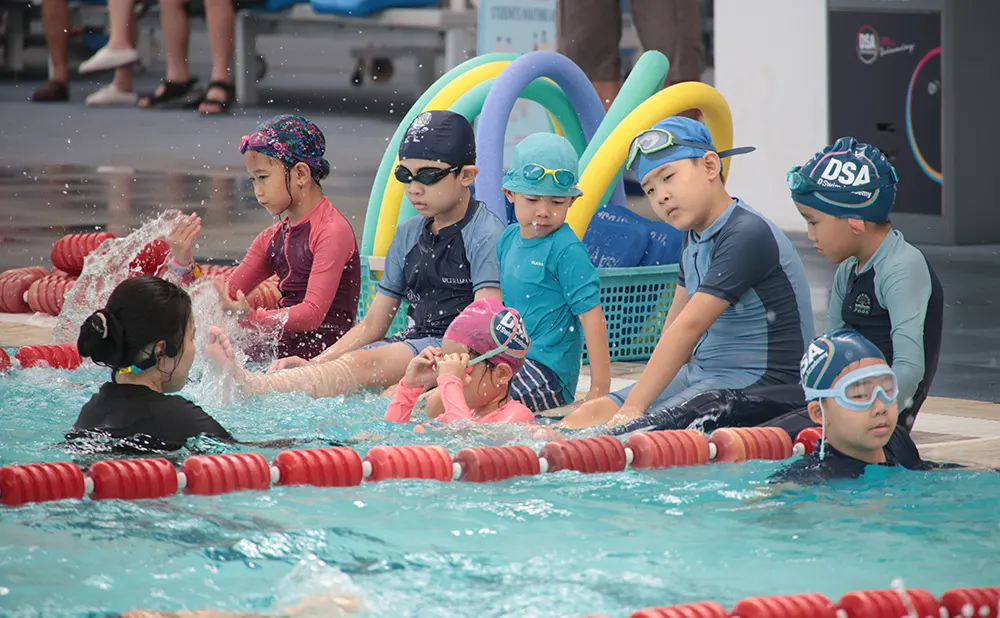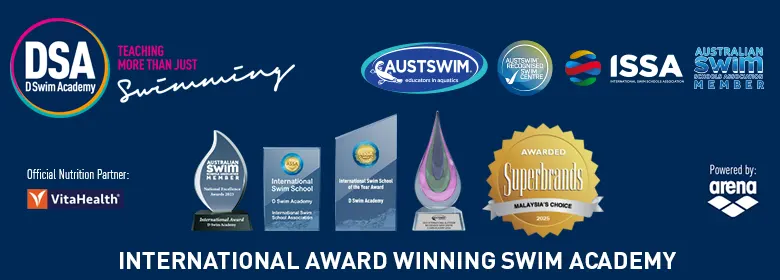For many parents, enrolling a child in their first swimming class marks an exciting milestone. It’s the moment when “playing in the water” begins to evolve into a life skill — one that builds confidence, coordination, discipline, and safety. But for working parents who value structured education and measurable progress, it’s also natural to ask: What should I expect from my child’s first swim class?
At D Swim Academy (DSA), swimming is not taught as a recreational activity but as a structured learning journey — designed with a clear progression map, measurable milestones, and professional instruction. Understanding this approach helps parents set the right expectations and recognise genuine progress when it happens.
Understanding the Structured Learning Pathway
Unlike informal swimming lessons, DSA’s programs are built on a clearly defined pathway that takes children from early water familiarisation to confident, independent swimming.
Each child’s journey begins in the “Learn to Swim” program — a curriculum tailored for children aged five and above. The pathway follows a colour-coded level system (Red, Pink, Yellow, Blue), and each colour includes two sub-levels. Children move forward based on mastery, not age or the number of classes attended.
This structure ensures that:
- Every skill builds on the last, preventing fear or poor technique.
- Parents know exactly where their child is in the learning map.
- Instructors assess readiness, not just attendance.
In short, DSA’s approach mirrors the structure of formal education — progression through demonstrated competency, rather than “time served.”
What happens in the first swim class
The first class is about comfort, safety, and orientation — not instant results. DSA’s instructors begin by helping children feel at ease in the water. Activities focus on:
- Entering and exiting the pool safely.
- Learning to blow bubbles and control breathing.
- Developing balance and body position in the water.
- Practising kicking, floating, and basic movement with support.
Instructors also take note of how each child responds — assessing water confidence, coordination, and comfort. This helps determine the most suitable starting level in the pathway (e.g., Red 1 or Red 2).
For parents, it’s important to understand that confidence comes before skill. Just as a child learns to walk only after feeling secure on their feet, swimming proficiency develops after comfort and trust are established in the water.
The role of qualified instructors
All DSA instructors are AUSTSWIM-recognised, which means they are certified to international standards in swimming and water safety education. This professional background ensures that teaching methods are safe, age-appropriate, and rooted in child psychology.
For working parents, this quality assurance matters — you’re not just paying for lessons; you’re investing in a recognised educational program that values long-term outcomes over quick wins.
Setting realistic expectations at your swim class
One of the most common misconceptions among parents is expecting visible swimming ability within a few sessions. DSA emphasises that children, like in academics, learn at different rates. Some may take a few weeks to develop basic comfort; others progress more rapidly.
Here’s what you should expect in the early weeks:
- Your child may cling to the instructor initially — that’s perfectly normal.
- Progress will be incremental — comfort, floating, kicking, then breathing.
- You’ll start seeing small but consistent milestones (longer breath control, improved balance, willingness to submerge).
Each level in DSA’s program culminates in clear outcomes. For example, by the end of the Red Level, your child should be able to float independently and demonstrate safe water entry and exit. Parents receive progress feedback and are encouraged to celebrate these early achievements.
Why structure delivers results
As professionals, you know that outcomes require structure — whether it’s in business, education, or skill development. Swimming is no different. The structured program at DSA ensures:
- Consistency: Each lesson builds on the last.
- Accountability: Parents can track progress via colour-coded levels.
- Confidence: Children develop naturally without feeling pressured.
- Foundation for growth: Once the fundamentals are mastered, they’re ready for higher levels — including squad training, diving, or artistic swimming.
This systematic approach is what transforms swimming from a leisure activity into a genuine life skill — delivered through professional, measurable education.
Your role as a parent for your child’s swim class
Parents play a vital role in reinforcing progress:
- Encourage regular attendance — consistency is key.
- Celebrate small milestones — confidence grows through recognition.
- Trust the process — avoid comparing progress with other children.
- Communicate with instructors — understanding what your child is learning helps support them emotionally.
Your child’s first swim class is the beginning of a journey — one that’s built on structure, patience, and proven methodology. At D Swim Academy, the goal isn’t just to teach swimming; it’s to build confident, capable, and safety-conscious young swimmers who love the water.
When you choose a program that’s structured, professional, and transparent about progress, you’re making a smart educational investment — one that delivers results not just in the pool, but in your child’s confidence and discipline beyond it.
NB: Children should always be accompanied by their parents or appointed guardians when in or around the pool or any water bodies. DSA provides Learn to Swim Programs for Children for all ages. Classes are available at multiple locations across Kuala Lumpur, Selangor and Shah Alam areas in the Klang Valley, Bandar Dato’ Onn, Johor and Seberang Jaya, Penang.
 Swimming Lesson in KL, Malaysia
Swimming Lesson in KL, Malaysia

